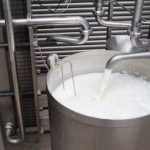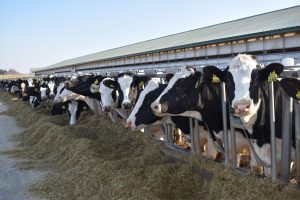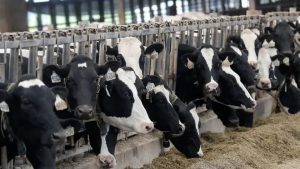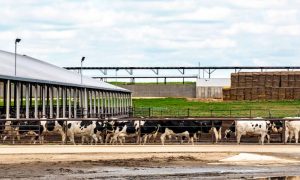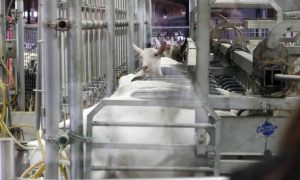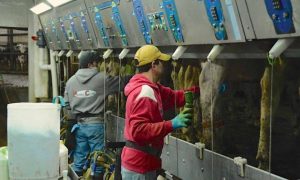
Cheese production totaled 1.162 billion pounds, down 0.7 percent from June and down 0.7 percent from July 2022. Output in the first seven months of 2023 totaled 8.2 billion pounds, up just 0.3 percent from 2022.
Wisconsin vats produced 291.7 million pounds of the July total, down 1.9 percent from June but 2.4 percent above a year ago. California, with 202.3 million pounds, was down 1.7 percent from June and 4 percent below a year ago. Idaho provided 86.8 million pounds, down 0.4 percent from June but 1 percent more than a year ago. New Mexico, at 82.8 million pounds, was up 3.9 percent from June and 4.5 percent above a year ago.
Italian cheese output totaled 481.6 million pounds, up 0.2 percent from June but 1.5 percent below a year ago. American output, at 475.2 million pounds, was up 0.3 percent from the June count which was revised down 4.8 million pounds, and was up 0.2 percent from a year ago. To date, American output stood at 3.4 billion pounds, up 2.3 percent. Mozzarella totaled 382.2 million pounds, down 2.6 percent from a year ago.
Cheddar output slipped to 331.5 million pounds, down 6.5 million pounds or 1.9 percent from June, and down 8.7 million or 2.6 percent from a year ago. Year-to-date, cheddar was at 2.4 billion pounds, up 2.5 percent from 2022.
Butter production fell to 157 million pounds, down 5.1 million pounds or 3.1 percent from June, but was up 5.2 million pounds or 3.5 percent from a year ago. Year-to-date, butter stood at 1.3 billion pounds, up 4 percent from a year ago.
Yogurt production totaled 396.2 million pounds, up 4.3 percent from a year ago.
Dry whey production totaled 88.2 million pounds, up 2.7 million pounds or 3.1 percent from June, and up 2.9 million or 3.4 percent from year ago. Year-to-date, whey stands at 554.2 million pounds, up 2.3 percent. Stocks grew to 86.9 million pounds, up 3.2 million pounds or 3.9 percent from June and up 14.8 million or 20.6 percent from a year ago.
Nonfat dry milk output dropped to 134.9 million pounds, down 43.1 million pounds or 24.2 percent from June and down 30.8 million or 18.6 percent from a year ago. Stocks fell to 283.3 million pounds, down 15.4 million pounds, or 5.2 percent from June, and down 49.8 million or 15 percent from a year ago.
Skim milk powder production jumped to 62.6 million pounds, up 25.2 million pounds or 67.3 percent from June, and up 1.6 million or 2.6 percent from a year ago. The report is viewed as bullish for cheese and powder and bearish on butter.
Strengthened some by the report, Chicago Mercantile Exchange block cheddar climbed to $1.9625 per pound on Sept. 6, but closed the second Friday of September at $1.925. This is down 2.5 cents on the Labor Day holiday shortened week and three-quarter cents above a year ago.
The barrels saw a Sept. 8 finish at $1.8275. This is 4.25 cents lower on the week, 10.5 cents below a year ago, and 9.75 cents below the blocks. There were only three loads of block traded on the week at the CME and two of barrel.
Aged cheese is abundant, says StoneX Dairy, but fresh cheese remains tight and the futures market seems to know that. At some point, presumably, there will be more fresh cheese available; but we don’t appear to be at that place yet.”
Milk availability continues to tighten in the Midwest, according to Dairy Market News. Cheesemakers say several milk handlers have “gone silent on offers.”
Spot loads at mid-week were reportedly $1 over Class III or higher.
Cheesemakers are growingly concerned about meeting demand — particularly mozzarella and pizza cheesemakers. Excessively available milk throughout the winter and spring kept cheesemakers very busy; but that’s not the case currently.
Retail and food service cheese demand is strong to steady in the West. Exports are moderate. Class III milk demand is strong by most cheese manufacturers and milk is in good balance with processing capacities. Cheese production is strong to steady but slipping farm level milk output may soon change that.
Butter climbed to $2.73 per pound on Sept. 7, but closed the next day at $2.68. This is up 2 cents and reverses two weeks of losses, but 49 cents below a year ago, with 49 sales reported for the week.
Cream availability varies but the holiday weekend provided butter plants extra product. Cream access is slowing and expected to tighten. Recent heat and humidity in the Midwest crimped milkfat output at the farm. Retail butter demand is steadily increasing and food service demand is notably improved, says Dairy Market News.
Cream tightness also eased in the West; but post-holiday volumes are slipping. Near-term cream is anticipated to be tight in the West. Spot loads are available but more limited. The tighter availability and higher spot prices are keeping buyers at bay, says Dairy Market News. Some report butter output is steady while others say churning is slower than anticipated due to less cream.
Grade A nonfat dry milk fell to $1.0575 per pound on Sept. 5 (the lowest CME price since Nov. 5, 2020), but rallied on Sept. 6, jumping 3.25 cents, and closed Sept. 8 at $1.10. This is up 2.5 cents, but still 47.5 cents below a year ago, on 21 sales.
Dry whey hit 32 cents per pound on Sept. 5 (the highest since May 8), but closed Sept. 8 at 30.25 cents. This is down a quarter-cent on the week, and 15.5 cents below a year ago. There were 11 sales reported for the short week.
Sept. 5’s Global Dairy Trade auction saw the weighted average head up for the first time since May 2, up 2.7 percent following declines of 7.4 percent on Aug. 15 and 4.3 percent on Aug. 1. Traders brought 83.2 million pounds of product to market, up from 74 million on Aug. 15. The average metric ton price crept to $2,888 U.S., up from $2,875 on Aug. 15.
Whole milk powder led the gains, jumping 5.3 percent after leading the declines on Aug. 15 with a 10.9 percent drop. Skim milk powder was down 1.6 percent after dropping 5.2 percent last time. Anhydrous milkfat was up 2.7 percent after dropping 5.3 percent, and butter was up 1.1 percent following a 3 percent decline. Cheddar was off 0.6 percent after jumping 5.8 percent on Aug. 15.
StoneX says the GDT 80 percent butterfat butter price equates to $2.0304 per pound U.S., up 2.2 cents from the Aug. 15 event, and compares to CME butter which closed Sept. 8 at $2.68. GDT cheddar, at $1.8608, was down 1.1 cent, and compares to Sept. 8’s CME block cheddar at $1.9250. GDT skim milk powder averaged $1.0367 per pound, down from $1.0583, and whole milk powder averaged $1.2255, up from $1.1558, (7 cents). CME Grade A nonfat dry milk closed on Sept. 8 at $1.10.
Analyst Dustin Winston reported, “North Asia, which includes China, was back to being the largest purchaser; but volume did move lower in this event from the last. SE Asia volume increased. Whole milk powder purchases from SE Asia and the Middle East were a big part of the support in whole milk powder prices.”
HighGround Dairy points out, “Fonterra announced that it was lowering its offerings of whole milk powder and skim milk powder, shifting volumes to the Pulse platform.
Rabo Bank analyst Lucas Fuess, speaking in the Sept. 11 “Dairy Radio Now” broadcast, said it remains to be seen if this was a bona fide turnaround in the GDT. Whole milk powder was up, he said, but skim milk powder was down; adding that New Zealand’s milk production season peaks in October and Fonterra has twice lowered its milk price expectations, so dairy farmers are facing a tough economic challenge.
While China’s depressed economy and purchases are on everyone’s minds, Rabo Bank released its Global Quarterly, focusing in part on the milk supply — which is contracting in most key regions like the United States, European Union, and New Zealand. “That sets us up with a supply side that isn’t necessarily firm,” Fuess stated. “Any sense of a demand recovery — especially if it comes quicker than expected — could mean we have finally reached the bottom on prices.”
With China becoming the world’s third-largest milk producer, global purchases will be reduced, according to Rabo Bank. But Fuess concluded China will not be self-sufficient enough and thus remain a big buyer of dairy products.
July milk production in New Zealand was another month of decreased output, according to Dairy Market News, and yields were smaller in June and July. Things are a little better in Australia, however. “Even with poor weather conditions in most regions, which has challenged milk production over the course of the 2022-23 season, Australia’s milk output ended the season with June up 1.2 percent. However, overall seasonal milk output posted a 5 percent decline,” says Dairy Market News.
July’s U.S. dairy exports showed a lot of declines from July 2022. Exports totaled 467.8 million pounds, down 10 percent or 51.8 million pounds. It was the fourth consecutive month of double-digit losses, according to HighGround Dairy.
Nonfat-skim milk powder exports were up 2.8 percent, thanks to hefty shipments to Mexico and Vietnam. But HighGround Dairy says, “Demand from China and other Southeast Asian nations, the Philippines, Indonesia, and Malaysia fell; which was unsurprising, given the ongoing reports of weak demand in those places and declining prices at recent GDT events.”
Total cheese exports were down 1.2 percent — the fourth consecutive month of decline. but an improvement from the double-digit decreases of April to June. HighGround Dairy pointed to “feeble demand from South Korea.”
Butter was down a whopping 61.3 percent as Canada, Mexico, and South Korea, the top three destinations, purchased less product.
By the way, Canada has lost a trade dispute with New Zealand involving its long-entrenched dairy quota system, a “sacred cow” the United States has challenged as well.
U.S. dry whey exports were down a hefty 42.6 percent — the most significant year-over-year percentage drop since July 2009, according to HighGround Dairy. Volumes were the smallest since October 2019.
Cooperatives Working Together continues to send product offshore. Member cooperatives accepted three offers of export assistance this week on sales of 388,000 pounds of American-type cheese. The product is going to customers in Asia through February 2024 and raised CWT’s 2023 exports to 33.9 million pounds of American-type cheeses, 809,000 pounds of butter, 26,000 pounds of anhydrous milkfat, 31.5 million pounds of whole milk powder and 6.2 million pounds of cream cheese.
The latest Crop Progress report showed 93 percent of U.S. corn in the dough stage as of the week ending Sept. 3. This is up from 88 percent the previous week, 2 percent ahead of a year ago, and 1 percent ahead of the five-year average. Sixty-seven percent was dented, up from 51 percent from the previous week, and 6 percent ahead of a year ago. Fifty-three percent was rated good to excellent, down 3 percent from the previous week, and 1 percent below a year ago.
The report shows 95 percent of the soybeans setting pods, up from 91 percent the previous week, and 1 percent ahead of a year ago and five-year the average. Fifty-three percent were rated good to excellent, down 5 percent from the previous week, and 4 percent below a year ago.
Dairy culling maybe slowing. The week ending Aug. 26 saw 59,200 cows go to slaughter, down 600 from the previous week and 800 or 1.3 percent less than a year ago. It is the first time since the week ending March 4 to be below a year ago. Year-to-date, 2,093,600 head have been culled, up 108,600 or 5.5 percent from a year ago.
Beef slaughter levels increased a bit over the last few weeks, but are still well below year-ago levels, says StoneX. “As a result, dairy cow slaughter continues to hold a greater volume of the beef market share compared to last year.”
“Dairy margins improved the second half of August as a continued recovery in milk prices more than offset a slight increase in projected feed costs,” says the Margin Watch from Chicago-based Commodity and Ingredient Hedging LLC.
The report detailed July Milk Production and Cold Storage data, stating, “July saw the first year-over-year decline in milk output so far in 2023 following USDA’s upper revision to June production.”
It also reported that the drawdown in July total cheese stocks was the largest year-over-year drop since late 2019 “as inventories have tended to increase between June and July in recent years, making this year’s drop even more noteworthy.”
“A return to hot and dry weather across the Western Corn Belt has added risk premium to the soybean meal market,” the Margin Watch concluded, “while corn prices have held steady.”
In politics, the Federal Milk Marketing Order hearing continues and the National Milk Producers Federation says it’s been “much as expected.”
“With NMPF’s proposed modernization plan serving as its bedrock, the topics under discussion very much reflect the areas we identified as key areas of improvement to FMMOs. At the same time, cross-examination and counter-proposals from other parties have been thorough, and at times, off-base.”
“Unsurprisingly, those questions and perspectives reflect the vested interests of the questioners, with changes often presented as zero-sum games in which the questioner’s ideas and opinions just-so-happen to benefit its bottom line. Our position at NMPF is a little different. We recognize that any proposal USDA puts up to a producer vote will need to meet a balance of interests, as admittedly, some regions, sizes or business models may benefit more than others depending on the issue. That’s a simple fact of reality in the world of policy progress. In that sense, we’re not always arguing specifically for the benefit of one party, we’re defending the consensus we’ve crafted that provides the greatest benefit to the industry as a whole — dairy farmers, processors, and consumers alike — because that’s the only approach that will bring the lasting improvements for the entire dairy industry,” NMPF argued.


